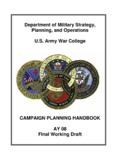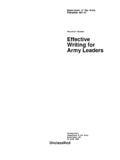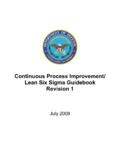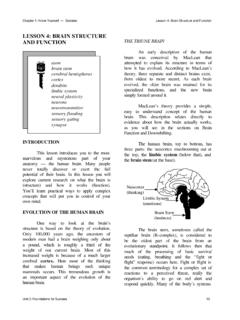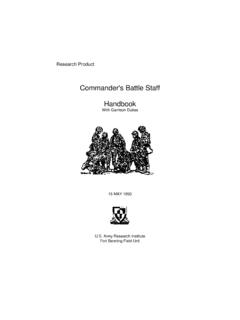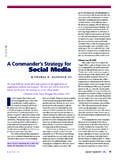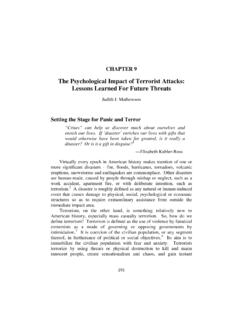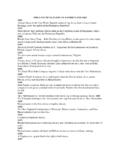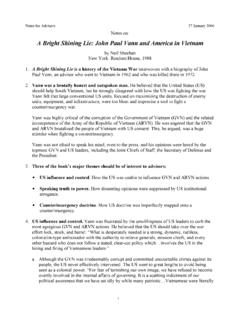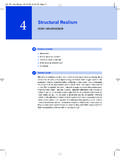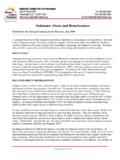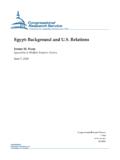Transcription of Best Practices in Counterinsurgency - Air University
1 8 May - June 2005lMILITARY REVIEWIt is fashionable in some quarters to say thatthe problems in Southeast Asia are primarily po-litical and economic rather than military . I donot agree. The essence of the problem in Viet-nam is military . General Earle Wheeler, 19621WE CAN DISCERN best Practices com-mon to successful counterinsurgenciesby studying the past century s insurgentwars. Historical analysis helps us understand thenature and continuities of insurgencies overtime and in various cultural, political, and geo-graphic settings. While this does not produce atemplate solution to civil wars and insurrections,the sum of these experiences, judiciously andappropriately applied, might help Iraq defeat on every continent have experiencedor intervened in insurgencies. Not counting militarycoups and territorially defined civil wars, there are17 insurgencies we can study closely and 36 othersthat include aspects we can consider.
2 (See chart 1.)Assessment reveals which Counterinsurgency prac-tices were successful and which failed. A strategicvictory does not validate all the victor s operationaland tactical methods or make them universally ap-plicable, as America s defeat in Vietnam and its suc-cess in El Salvador demonstrate. In both cases, learning more from one s mistakes than one sachievements is a valid axiom. If we were to com-bine all the successful operational Practices from acentury of counterinsurgent warfare, the summarywould suggest a campaign outline to combat the in-surgency in present-day Iraq. (See chart 2.)Chart 1. Selected 20th-Century InsurgenciesSecond Anglo-Boer War (United Kingdom [ ]vs. Boer separatists, 1899-1902).Philippine Insurrection (United States [ ] nationalists, 1899-1902 [1916]).Arab Revolt (Ottoman Turkey vs.)
3 Arab rebels, 1916-1918).Iraq 1920 ( vs. Iraqi rebels, 1920).China (Nationalist Party [KMT] vs. Communists, 1922-1949).Nicaraguan Intervention ( and Government ofNicaragua [GoN] vs. Sandinistas, 1925-1932).France, World War II (Germany vs. French resistanceand Special Operations Executive [SOE]/Office ofStrategic Services [OSS], 1940-1945).Balkans, World War II (Germany vs. Tito s partisansand SOE/OSS, 1940-1945).Greek Civil War ( , then and Government ofGreece [GoG], vs. National Liberation Army [ELAS],1944-1949).Indonesian Revolt (Netherlands vs. Indonesianrebels, 1945-1949).French Indochina (France vs. Viet Minh, 1945-1954).Palestine ( vs. Jewish separatists, 1945-1948).Hukbalahap Rebellion (Philippine Islands [ ] , 1946-1954).Malayan Emergency ( vs. Malayan CommunistParty [MPC]/Malayan Races Liberation Army [MRLA],1948-1960).
4 Kenyan Emergency ( vs. Mau Mau, 1952-1956).Algerian Revolt (France vs. National Liberation Front[FLN], 1954-1962).Cyprus ( vs. Ethniki Organosis Kyprios Agoniston[EOKA] (a Greek terrorist organization), 1954-1959).Aden ( and Aden vs. Yemeni insurgents, 1955-1967).Cuban Revolution (Cuba s Batista regime vs. Castro,1956-1959).France (France vs. Secret Army Organization [OAS],1958-1962).Venezuela (Venezuela vs. urban-based Armed Forcesfor National Liberation [FALN], 1958-1963).Vietnam War ( and Government of Vietnam[GoVN] vs. National Liberation Front [NLF] andDemocratic People s Republic of Vietnam [DPRVN],1958-1975).Guatemalan Civil War (Guatemala vs. Marxist rebels,1961-1996).Angola (Portugal vs. Popular Movement for theLiberation of Angola [MPLA], 1961-1974).Guinea-Bissau (Portugal vs. Marxist rebels, 1963-1974).Chart 1. Selected 20th-Century InsurgenciesBest Practices inCounterinsurgencyKalev I.
5 Sepp, REVIEWlMay - June 2005 Successful Operational PracticesThe focus of all civil and military plans and op-erations must be on the center of gravity in any con-flict the country s people and their belief in andsupport of their government. Winning their heartsand minds must be the objective of the government Because this is a policy objective, it mustbe directed by the country s political leaders. Colom-bian President Alvaro Uribe pursued this course andgained broad support of the populace in the struggleagainst the Revolutionary Armed Forces of Colom-bia and National Liberation Army government is weakening the insurgents holdon their traditional zones of control and threateningtheir financial and recruiting rights. The security of the people mustbe assured as a basic need, along with food, water,shelter, health care, and a means of living.
6 Theseare human rights, along with freedom of worship,access to education, and equal rights for failure of counterinsurgencies and the root causeof the insurgencies themselves can often be tracedto government disregard of these basic rights, as inKuomintung, China; French Indochina; Batista sCuba; Somoza s Nicaragua; and Soviet-occupiedAfghanistan, among others. Recognition and as-surance of these rights by the government hasbeen essential to turning a population away frominsurgents and their the 1950s Malaya Emergency, BritishHigh Commissioner Sir Gerald Templer a declaredantiracist strived for political and social equality ofall Malays. He granted Malay citizenship en masseto over a million Indians and Chinese; required Brit-ons to register as Malay citizens; elevated the pub-lic role of women; constructed schools, clinics, andpolice stations; electrified rural villages; continued a700-percent increase in the number of police andmilitary troops; and gave arms to militia guards toprotect their own communities.
7 In this environment,insurgent terrorism only drove the people furtherfrom the rebels and closer to the enforcement. Intelligence operations thathelp detect terrorist insurgents for arrest and pros-ecution are the single most important practice to pro-tect a population from threats to its security. Hon-est, trained, robust police forces responsible forsecurity can gather intelligence at the communitylevel. Historically, robustness in wartime requiresa ratio of 20 police and auxiliaries for each 1, turn, an incorrupt, functioning judiciary mustsupport the police. During a major urban insurgencyfrom 1968 to 1973, the Venezuelan Governmentappointed the head of military intelligence as thesenior police chief in Caracas. He centralizedUruguay (Uruguay vs. Tupamaros, 1963-1972).Mozambique (Portugal vs. Front for the Liberation ofMozambique [FRELIMO], 1964-1974).
8 Colombian Civil War ( and Government ofColombia [GoC] vs. Revolutionary Armed Forces ofColombia [FARC] and National Liberation Army[ELN], 1964-present).Northern Ireland ( vs. Irish Republican Army [IRA],1968-present).Weather Underground (WU) ( vs. Students for aDemocratic Society [SDS]/WU, Black Panthers, Sym-bionese Liberation Army [SLA] et al., 1968-1980).Spain (Spain vs. Basque Euzkadi Ta Askatasuna [ETA](Basque fatherland and liberty), 1968-present).Oman ( and Oman vs. Popular Front for theLiberation of Oman and the Arab Gulf [PFLOAG],1969-1976).Germany (Germany vs. Baader-Meinhof/Red ArmyFaction [RAF], 1970-1992).Philippines ( vs. New People s Army [NPA] andMoro National Liberation Front [MNLF]/Moro IslamicLiberation Front [MILF], 1970-present).Sri Lanka (Sri Lanka vs. Tamil New Tigers [TNT],1972-present).Palestine (Israel vs.)
9 Palestine Liberation Front [PLF]et al., 1973-present).Rhodesia (Rhodesia vs. Zimbabwe African People sUnion [ZAPU] and Zimbabwe African National Union[ZANU], 1974-1980).Western Sahara (Morocco vs. Western SaharaFreedom Movement [POLISARIO], 1975-1991).Soviet-Afghan War (Union of Soviet Socialist Repub-lics [USSR] and Government of Afghanistan [GoA] , 1979-1988).Salvadoran Civil War ( and Government of ElSalvador [GoES] vs. Farabundo Marti NationalLiberation Front [FMLN], 1979-1991).Senderista Insurgency (Peru vs. Sendero Lumi-noso, 1980-1995; vs. Tupac Amaru RevolutionaryMovement [MRTA], 1996-1997).Nicaragua (Frente Sandinista Deliberacion Nacional[FSLN] vs. National Guard [GN]/Contras, 1980-1990).Kashmir (India vs. Kashmiri Muslim separatists,1988-present).Algeria (Algeria/National Liberation Front [FLN] Salvation Front [FIS]/Armed Islamic Group[GIA], 1992-present).
10 Somalia Humanitarian Relief Mission ( and UNvs. armed factions, 1992-1994).Chechnya (Russia vs. Chechen separatists, 1994-present).Nepal (Nepal vs. Maoists, 1996-present).Afghanistan ( and GoA vs. Taliban, 2001-present).Iraq (Government of Iraq [GoI] and coalitionvs. jihadists and insurgents, 2003-present).COUNTERINSURGENCY10 May - June 2005lMILITARY REVIEW command of all Venezuelan police and reorganized,retrained, and reformed them. They fought andeventually defeated the necessary, military and paramilitary forces cansupport the police in the performance of their law-enforcement duties. From 1968 to 1972, Vietnam-ese police and intelligence services, with military sup-port, carried out project Phung Hoang, arresting andtrying over 18,000 members of the nationwide VietCong command and intelligence control. Insurgents rely on membersof the population for concealment, sustenance, andrecruits, so they must be isolated from the peopleby all means possible.
